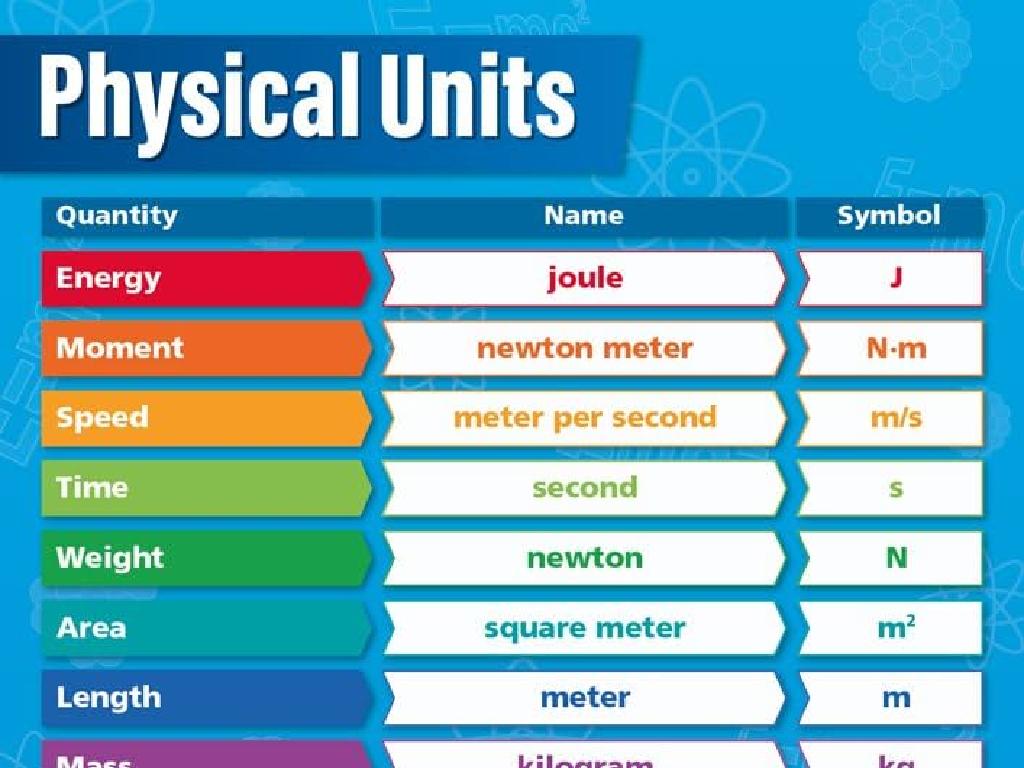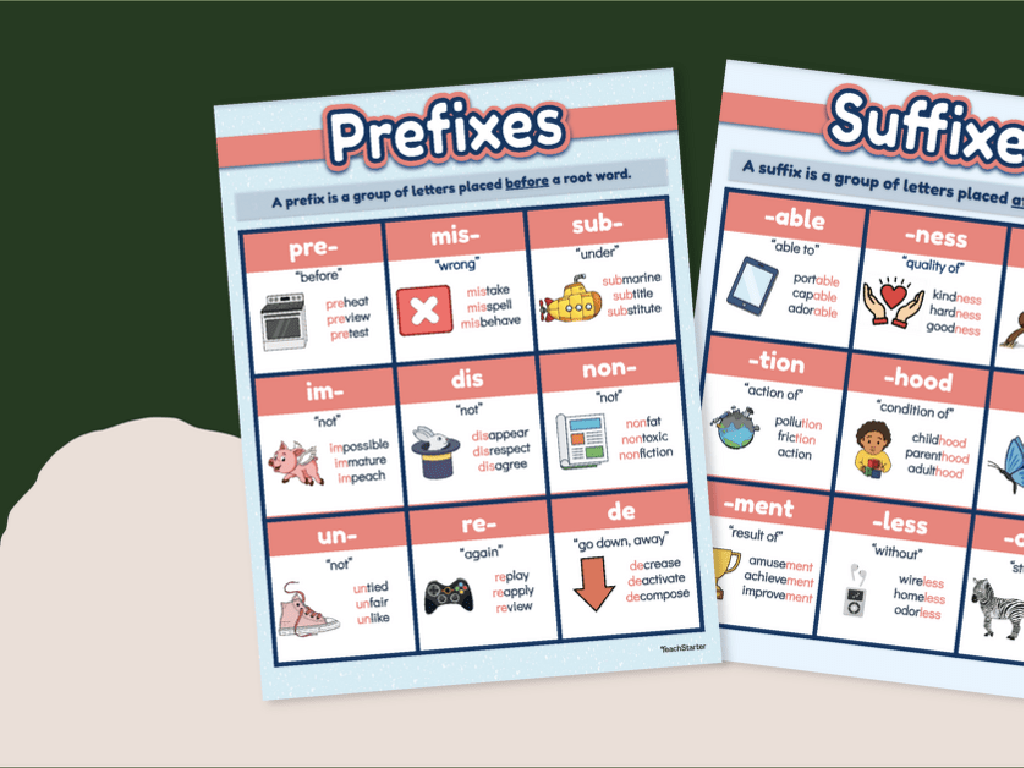Compare Rates: Word Problems
Subject: Math
Grade: Sixth grade
Topic: Ratios And Rates
Please LOG IN to download the presentation. Access is available to registered users only.
View More Content
Comparing Rates: Word Problems
– Understanding ratios and rates
– Ratios compare two quantities, like 2 apples for every 3 oranges.
– Daily applications of rates
– Rates are used in speed (miles/hour), density (people/square mile).
– Focus: Word problem comparison
– Learn to find which is a better deal or faster option through problems.
– Strategies for solving problems
|
This slide introduces students to the concept of ratios and rates, setting the stage for understanding how to compare different rates through word problems. Begin by explaining ratios as a comparison between two quantities and rates as ratios that involve different units. Illustrate with everyday examples such as speed limits or population density to make the concepts relatable. The main focus of the lesson is on comparing rates using word problems, which will help students develop critical thinking and problem-solving skills. Emphasize strategies such as unit conversion and cross-multiplication to compare rates effectively. Encourage students to practice with real-life scenarios to reinforce their understanding.
Understanding Rates in Everyday Life
– Define a rate
– A rate is a ratio that compares two different units, like miles per hour.
– Daily examples of rates
– Examples: speed of a car (mph), price of fruit (per pound)
– Rate vs. ratio comparison
– A ratio compares two quantities of the same unit, while a rate compares two different units.
– Significance of rates in math
|
This slide introduces the concept of rates, which are an essential part of understanding real-world math applications. Begin by defining a rate as a special type of ratio that compares two different units. Provide relatable examples such as the speed of a car or the price of fruit to illustrate rates that students encounter daily. Clarify the difference between a rate and a ratio, emphasizing that a rate involves different units. Highlight the importance of understanding rates for solving practical problems in various contexts, such as shopping, traveling, and cooking. Encourage students to think of other examples of rates they know from their daily lives.
Understanding Word Problems: Rates
– Identify important information
– Look for numbers, units, and what’s being compared.
– Recognize keywords for rates
– Words like ‘per’, ‘each’, or ‘every’ signal rates.
– Break down problems into parts
– Divide the problem into ‘what we know’ and ‘what we need to find out’.
– Practice with example problems
– Use a sample problem to apply these steps.
|
This slide is aimed at helping students tackle word problems involving rates. Start by guiding them to identify crucial information such as quantities and units. Emphasize the importance of keywords that indicate rates, such as ‘per’, ‘each’, or ‘every’. Teach them to deconstruct the problem into smaller, more manageable parts, which makes it easier to solve. Finally, provide practice with example problems to reinforce the concepts. Encourage students to explain their reasoning for each step, which will help solidify their understanding and ability to solve rate problems.
Comparing Rates: Word Problems
– Use division to compare rates
– Divide to find the rate per unit, like miles per hour
– Find a common unit for comparison
– Convert rates to the same unit, like price per ounce
– Analyze real-life rate problems
– Compare deals using unit rates, such as cost per item
– Determine the better deal
– Use math to decide which option offers more value
|
This slide introduces students to the concept of comparing rates through division to find the unit rate, which is essential for making fair comparisons. Students should learn to find a common unit to compare different rates effectively. Real-life examples, like comparing prices of different-sized packages in a grocery store, will help them understand which option is a better deal. Encourage students to think critically about rates they encounter in daily life and to use unit rates to make informed decisions. Provide practice problems where students can apply these concepts to determine the most economical choices.
Comparing Rates in Word Problems
– Carefully read the problem
– Identify rates for comparison
– Find the two rates in the problem that you need to compare
– Calculate the unit rate
– Use division to find the rate per one unit
– Determine the better rate
– Compare the unit rates to see which one offers a better deal
|
This slide is aimed at teaching students a systematic approach to solving word problems involving comparison of rates. Start by reading the problem thoroughly to understand what is being asked. Next, identify the specific rates that need to be compared. Then, use division to calculate the unit rate for each item or scenario. The unit rate is the cost or value of one single unit, which allows for an apples-to-apples comparison between different rates. Finally, compare the unit rates to determine which one is more economical or offers a better value. Encourage students to practice with real-world examples, such as comparing prices per ounce of different brands at a grocery store, or speeds of different animals or vehicles. Provide several practice problems and guide them through the process to ensure understanding.
Comparing Rates: Practice Problem #1
– Identify the rates in the problem
– Calculate the unit rates
– Divide to find the rate per 1 unit
– Determine the better rate
– Compare the unit rates to decide
– Discuss the reasoning
– Explain why one rate is more favorable
|
This slide is designed for a collaborative classroom activity where students will apply their knowledge of rates to solve a word problem. Start by reading the problem aloud and identifying the different rates given. Guide students through the process of calculating the unit rates by dividing the given rate by the number of units. Once the unit rates are found, facilitate a discussion on which rate is better based on the context of the problem and why. Encourage students to think critically about the real-world implications of choosing one rate over another. Possible activities could include group work where each group tackles a different problem, or peer teaching where students explain their reasoning to the class.
Practice Problem #2: Compare Rates
– Attempt the problem individually
– Recall the steps we learned
– Think about the problem-solving methods we’ve covered
– Write down your solution
– Class discussion of the answer
– We’ll compare and learn from each other’s approaches
|
This slide is designed as a class activity to reinforce the students’ understanding of comparing rates through word problems. Encourage the students to try solving the problem on their own, reminding them to use the steps we’ve discussed in class, such as identifying the rates, setting up a ratio, and finding a common unit if necessary. After they’ve written down their solutions, we will review the answers as a class. This will allow students to learn from each other’s problem-solving methods and understand different ways to approach the same problem. Possible activities could include peer review, group discussions, or presenting solutions on the board.
Class Activity: Rate Race!
– Form small groups for research
– Find real-life rates to compare
– Look for rates like speed, price per unit, etc.
– Use various sources for examples
– Magazines, ads, and the internet are great resources
– Present your findings in class
|
This activity is designed to engage students with real-world applications of rates. Divide the class into small groups and assign each group to find different rates from everyday life, such as the speed of a car, cost per pound of fruit, or pages read per hour. Encourage them to use magazines, advertisements, or the internet to find examples. Each group will then compare the rates they’ve found and present their findings to the class. This will help them understand the concept of rates in a practical context. For the presentations, students should explain how they found their rates and why they are relevant. Possible activities: 1) Comparing travel speeds of different animals, 2) Price comparisons per unit weight/volume of products, 3) Comparing words read per minute by different classmates, 4) Analyzing fuel efficiency of family cars.
Conclusion & Homework: Mastering Rates
– Recap on comparing rates
– Practice is key to mastery
– Homework: Find and compare two rates
– Look for rates in real life, like speed of animals or price of fruits per pound
– Be ready to discuss in class
|
As we wrap up today’s lesson on comparing rates, it’s crucial to emphasize the importance of practice in mastering this concept. For homework, students are tasked with finding two rates from their daily lives to compare this could be anything from the speed of different family pets to the price of various fruits per pound at the grocery store. Encourage creativity and ensure they understand the assignment’s purpose is to apply what they’ve learned in a real-world context. In the next class, students will share their findings, fostering a discussion that will reinforce their understanding of rates and how to compare them.






